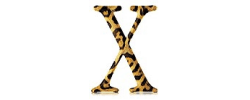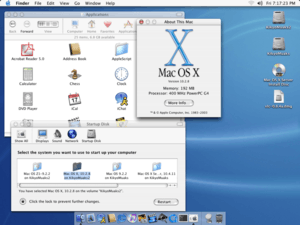Mac OS X 10.2
| A version of the Mac OS X operating system | |
 | |
|
Screenshot of Mac OS X v10.2 Jaguar | |
| Developer | Apple Inc. |
|---|---|
| Source model | Closed source (with open source components) |
| Released to manufacturing | August 24, 2002 |
| Latest release | 10.2.8 / October 3, 2003[1] |
| Platforms | PowerPC |
| Kernel type | Hybrid kernel |
| License | Apple Public Source License (APSL) and Apple end-user license agreement (EULA) |
| Preceded by | Mac OS X v10.1 Puma |
| Succeeded by | Mac OS X v10.3 Panther |
| Support status | |
| Unsupported | |
Mac OS X version 10.2 Jaguar is the third major release of Mac OS X, Apple's desktop and server operating system. It superseded Mac OS X v10.1 and preceded Mac OS X Panther. The operating system was initially available on August 23, 2002 either for single-computer installations, and in a “family pack”, which allowed five installations on separate computers in one household.[2] The operating system was generally well received by most Mac users as a large step forward in the areas of stability, general speed enhancements, compatibility with other flavors of Unix and the lineup of both graphical and terminal applications available; however, many critics, such as Amazon.com users,[3] still claimed that significant user interface speed issues existed and that the operating system was still a big step down from Mac OS 9. Jaguar was the first Mac OS X release to publicly use its code name in marketing and advertisements,[4] a practice that has continued in subsequent releases of the operating system.
System requirements
Supported Computers:[5]
- PowerMac G3
- PowerMac G4
- Early PowerMac G5
- iMac
- eMac
- PowerBook G3
- PowerBook G4
- iBook
Amount of RAM Required:
- 128 megabytes (MB), although 256 MB to 512 MB is highly recommended by many people who have used Mac OS X v10.2.8 as the real amount of RAM used when only the Operating System is running is around 200 MB, but it can be run with as low as 96 MB although it will not run at full speed.
Processor Type:
- PowerPC G3, G4 or G5 running at 233 MHz or higher.
New and changed features
End-user features
Apple advertised that Mac OS X v10.2 Jaguar had new features, such as:
- Address Book — A system-wide repository for contact information in the updated Address Book.
- Rendezvous (later named Bonjour) — Apple's implementation of an IETF open protocol (Zeroconf) that allows devices over a network to essentially ‘find each other’ with a directory listing service. For example, a Bonjour-enabled printer connected to a network, could find and connect to a Bonjour-enabled computer without any user configuration. This technology is used today in applications like iTunes music sharing and iChat Bonjour messaging.
- CUPS (Common Unix Printing System), the modular printing system for Unix-like operating systems.
- Finder — A revamped Finder with search box built into every window.
- Mail — An email client with an adaptive spam mail filter.
- Network support for Windows networks — Increased support for networks in Jaguar. Apple added much more support for Windows networks, and sharing protocols. Most of the changes were added behind the scenes, which included new Samba tools, and new printing protocols.
- Quartz Extreme — Quartz Extreme was added for compositing graphics directly on the video card, without the use of software to composite windows. The technology allotted the task of drawing the 3D surface of windows to the generally idle graphics processing unit, rather than to the central processing unit. Overall, the technology benefited the areas of user interface responsiveness and general speed enhancements throughout.
- Sherlock 3 — Internet services
- Universal Access — Set of features made specially for disabled people.
- QuickTime 6 has MPEG-4 support
- Increased speed across the entire system.
- Journaled file system (first introduced in 10.2.3 Server, later made available to 10.2.x clients).
New application in Jaguar
Marketing
In October 2002, Apple offered free copies of Jaguar to all U.S K-12 teachers as part of the "X For Teachers" program. Teachers who wanted to get a copy simply had to fill out a form and a packet containing Mac OS X installation discs and manuals was shipped to the school where they worked.[6]
Jaguar marked the first Mac OS X release which publicly used its code name as both a marketing ploy and as an official reference to the operating system. To that effect, Apple replaced their standard Mac OS X box with a new jaguar-themed box.
Mac OS X v10.2 was never officially referred to as Jaguar in the United Kingdom due to an agreement with the car manufacturer Jaguar, although boxes and CDs still bore the Jaguar-fur logo.
Starting with Jaguar, OS X releases were given a feline-related marketing name upon announcement until the introduction of OS X Mavericks in June 2013, at which point OS X releases began to be named after locations in California. OS X releases are now also referred to by their marketing name, in addition to version numbers.
Release history
| Version | Build | Date | OS name | Notes |
|---|---|---|---|---|
| 10.2 | 6C115, 6C115a | August 24, 2002 | Darwin 6.0 | Original retail release |
| 10.2.1 | 6D52 | September 18, 2002 | Darwin 6.1 | About the Mac OS X 10.2.1 Update, codename Jaguar Red |
| 10.2.2 | 6F21 | November 11, 2002 | Darwin 6.2 | About the Mac OS X 10.2.2 Update, codename Jaguar Blue or Merlot |
| 10.2.3 | 6G30 | December 19, 2002 | Darwin 6.3 | About the Mac OS X 10.2.3 Update, codename Jaguar Green |
| 6G37 | Updated retail release | |||
| 6G50 | Server edition; retail release | |||
| 10.2.4 | 6I32 | February 13, 2003 | Darwin 6.4 | About the Mac OS X 10.2.4 Update, codename Jaguar Pink |
| 10.2.5 | 6L29 | April 10, 2003 | Darwin 6.5 | About the Mac OS X 10.2.5 Update, codename Jaguar Plaid |
| 10.2.6 | 6L60 | May 6, 2003 | Darwin 6.6 | About the Mac OS X 10.2.6 Update, codename Jaguar Black |
| 10.2.7 | 6R65 | September 22, 2003 | Darwin 6.7 | Removed from distribution due to defects |
| 10.2.8 | 6R73 | October 3, 2003 | Darwin 6.8 | About the Mac OS X 10.2.8 Update; released as 6R50 for one day |
| 6S90 | About the Mac OS X 10.2.8 (G5) Update |
Mac OS X v.10.2.7 (codenames Blackrider, Smeagol) was only available to the new Power Mac G5s and aluminum PowerBook G4s released before Mac OS X Panther. Officially, it was never released to the general public.
Mac OS X v.10.2.8 is the last version of Mac OS X officially supported on the ‘beige G3’ desktop and minitower systems, as well as the PowerBook G3 Series (1998) also known as Wallstreet/PDQ; though later releases can be run on such Macs with the help of unofficial, unlicensed, and unsupported third-party tools such as XPostFacto.
Also, the famous Happy Mac that had greeted Mac users for almost 18 years during the Macintosh startup sequence was replaced with a large grey Apple logo with the introduction of Mac OS X 10.2.
References
- ↑ http://docs.info.apple.com/article.html?artnum=120245
- ↑ Fried, Ian (August 15, 2002). "Apple gives break to multi-Mac homes". News.com. Archived from the original on December 8, 2012.
- ↑ "Amazon.com: Customer Reviews: Mac OS X 10.2 Jaguar [OLD VERSION]".
- ↑ University of California: About Mac OS 10.2 (Jaguar) and 10.3 (Panther);retrieved September 7, 2013
- ↑ Amazon.com, Inc. (2005). Product Description: Mac OS X 10.2 (Jaguar). Retrieved on November 1, 2005.
- ↑ "Apple Gives Jaguar Free to All U.S. K-12 Teachers". Apple.com. Retrieved June 21, 2011.
External links
| ||||||||||||||||||
